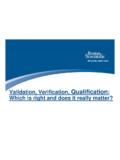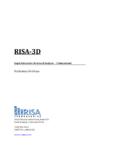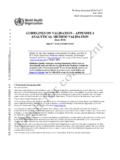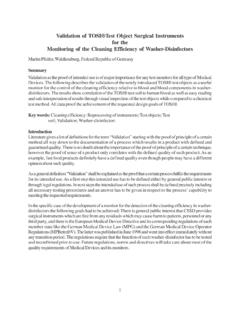Transcription of Spreadsheet Design, Verification and Validation, Use and ...
1 DFS/ORA Laboratory Information Bulletin No. 4349 Software Verification Page 1 of 25 Spreadsheet design , Verification and validation , Use and Storage of Single-User Workbook Files in the US FDA Laboratories Part II by Dennis Cantellops, San Juan District Introduction Two Laboratory Information Bulletins (LIBs)* covering the design , testing, Verification and validation of spreadsheets have been prepared. Part I covers the general principles of Spreadsheet application to be employed by several users (multi-users). This document (Part II) covers the spreadsheets to be used by single-users. It includes the use and storage of single-user Spreadsheet files, the design aspects of spreadsheets and the Verification and validation documentation for reporting in a regulatory environment.
2 The discussion pertains to applications of the Microsoft Excel Spreadsheet program. Due to the variability and complexity of sample analyses in FDA laboratories, analytical Spreadsheet applications are often modified or created in actual time, as an analyst performs the analytical procedure. This paper relates to a single-user Spreadsheet which is intended to be used by a single analyst, its creator, at one specific point in time for one time use depending of the type (single-user template or module). The single user Spreadsheet can take various forms, but in general it is a single workbook file which is relatively simple because it is based on uncomplicated formula construction and does not contain macros, color-coding, cells protection or instruction worksheets.
3 These features are not needed when the Spreadsheet is intended for personal use, since the developer knows how to identify the raw data, cell locations of formulas, data-entry cells and cell addresses. The single user Spreadsheet usually follows one of two basic options: A) A single-user workbook file can be created from a pre-developed single user template, which can contain approved and protected FDA forms ( forms 431, 431a, and nutrition sample transfer form) and worksheet examples to aid the analyst in undertaking the sample analysis with the Spreadsheet . The single user template is installed in a shared network location for use by the analysts.
4 After the single user template is opened, it is saved as a single-user workbook file in a designated folder on a personal drive for * Note: The Laboratory Information Bulletin is a tool for the rapid dissemination of laboratory methods (or information) which appear to work. It does not report completed scientific work. The user must assure himself / herself by appropriate validation procedures that LIB methods and techniques are reliable and accurate for the intended use. Reference to any commercial materials, equipment, or process does not in any way constitute approval, endorsement, or recommendation by the US Food and Drug Laboratory Information Bulletin No. 4349 Software Verification Page 2 of 25 personal use.
5 The individual analyst can perform data entries and modifications to handle raw and secondary data. This single-user workbook file will increase in file size because the analyst will add the additional data including formula construction and additional formatting to complete the sample analyses. B) Another way to implement the single-user workbook file is to develop it from an empty workbook the analyst opens an empty workbook with unpopulated worksheets (or opens a previously used version from the local drive for use in the development of the necessary worksheets). For this article we shall refer to this process as using a single user module. During the creation and data population (data-entry) stages of the single-user workbook files, the analyst uses the same formatting practices as if it was a hand-written worksheet.
6 The creator should perform in-process Verification of any formulas by manual calculations during the developmental stage of the workbook file. These verifications should be documented and the evidence of correct operation should be attached with the future workbook results, either in paper form or as a separate worksheet if the Verification is performed electronically using one of the referenced auditing tools. After completion, but prior to data use or approval, a second analyst verifies the calculations and data integrity of the printed sample worksheet using the visible data and the formulas displayed by the auditing tools. Therefore, the degree of the Verification depends on the module complexity.
7 In either of the two options mentioned, whether the single user workbook is created from a single user template or a single user module, the workbook file must not be transferred between the analysts. This is explained on section under Managing Single-User Workbook Files , page 14. In addition, a copy of the completed, verified and printed sample worksheet shall be maintained for documentation in the laboratory for future worksheet audits against the saved single user workbook file. The Power Pak Utility-PUP (1) mentioned in Part I (2), or the ABB Spreadsheet Specification and Reporting Tool (3), can be used to audit the single-user workbook file templates during the testing and Verification stages.
8 It is important that effective and appropriate principles and procedures be applied to all stages of producing analytical spreadsheets . At the design stage, such principles include design standards, clarity of formulas, documentation, and user-friendliness. Furthermore, when the basic principles of software engineering techniques are applied to the construction of Spreadsheet models, many errors are reduced or eliminated. Notes: 1. Excel documents are called workbook files. Each workbook is made up of individual spreadsheets called worksheets and sheets containing charts called chart sheets. 2. In summary Spreadsheet is only really used as a generic term whereas single-user template , is the read only template, single-user module is the empty file ready for development and single-user workbook , is a saved analyst file (it can be created from either the template or a module).
9 DFS/ORA Laboratory Information Bulletin No. 4349 Software Verification Page 3 of 25 Below there is a table describing the differences between the Single-User Template1, Single-User Modules2, Single-User Workbooks3, and Multi-User application. Table 1 Differences between analytical spreadsheets (Single-User Template1, Single-User Modules2, Single-User Workbooks3, and Multi-User) Spreadsheet Attributes Single 1 User Template Single 2 User ModuleSingle 3 User WorkbookMulti-user Created from empty Spreadsheet 3 Designed for use by one analyst 3 3 3 Can be opened by more than one analyst 3 3 3 Can be populated by more than one analyst 3 May contain complex formulas 3 May contain macros 3 3 May contain color coded data-entry 3 3 3 Should protect cells, whenever possible 3 3 3 May contain instruction worksheets 3 3 3 May contain protected forms ( , 431 and 431a)
10 3 3 3 During population, formulas checked by calculator 3 Second analyst verifies raw data entry 3 3 Second analyst verifies calculations integrity 3 Electronic workbook file is saved 3 3 Contains unprotected worksheets 3 3 3 May insert worksheets 3 3 3 Needs validation documentation 3 3 Needs in-process Verification of formulas during the population stage 3 Should verify data-entry 3 3 Notes: 1) The Single User Template1 and the Single User Module2 only exist prior to use. Once they are opened and saved, they become a Single User Workbook3. The differences between single and multi-user spreadsheets are summarized in Table 1 above. 2) For single-user workbook files standard formulas (such as Round and statistical functions) need to be verified for accuracy by the creator and by the reviewer (second check analyst).



